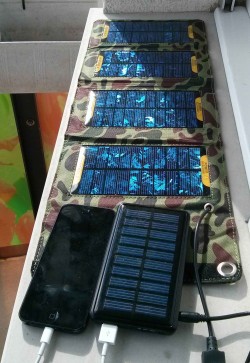
I have a vision for solving world hunger: each person just needs to have a small pot in their appartement and grow salad in them. So they will have food. Problem fixed, hand-over the Nobel price please. Thank you very much!
Of course, this is a silly idea – the numbers just don’t add up. It takes many days to grow a single salad, and you need more than a salad every other week to feed a human, not to mention this winter thing. People realise this, because they somehow understand what quantity of food they eat, how fast salads grow. This does not mean that having every person grow her own salad is bad idea, just that it won’t solve world hunger.
When the topic turns to energy, all the common sense flies out of the window: people don’t understand the quantities, so everything seems possible. A typical example is this solar powered window socket. Looks neat no? Just stick the thing to a window, it uses solar energy to recharge itself and acts as a power plug. Cool, no?
This device would contain a 1000mA/h battery that is charged in 10 hours. First problem the voltage is not specified, but if the battery charges in 10 hours, we need a 100mA solar panel. With the current technology, a panel a tad larger that the one in that device would output 100mA at 5V, so let take that as a baseline.
So we have 1A/h at 5V, which gives us 5 W/h (18 KJ) So what can you do with this amount of energy?
- Run a 1000W hair-drier for 18 seconds.
- Run a 100W LCD television set for 3 minutes.
- Run a 40W incandescence light-bulb for 4½ minutes.
- Run a 10W LCD light-bulb for half an hour.
- Charge an iPhone 4 (5.254 W/h) to 95%.
- Charge an iPhone 5s (5.966 W/h) to 84%.
- Charge a Nexus 7 (16 W/h) to 31%
- Boil 7 ml of water.
All this is assuming no conversion loss, which would be hard, as the battery would be 5V DC but the plug is 230V AC.
Now I have a solar charger, but it is much larger, and by experience, it produces just enough power to charge an auxiliary battery with an USB plug, which in turn can charge my phone (see picture). All this is done using USB cabling at 5V. This is convenient when travelling, but again, not a solution for energy problems and certainly does not look as stylish as the clean vision of the small plug stuck onto the window.
If you want to have solar power, you need a large surface, for the same reason that if you want to feed people, you need a field… You also might want to do that outside of the house’s windows, which tend to reflect ultra-violet lights.

Il y avait un article là-dessus dans un C’t l’an dernier.
Mon résumé :
http://www.courtois.cc/blogeclectique/index.php?post/Des-petits-panneaux-solaires
Aperçu de l’article :
http://www.heise.de/ct/inhalt/2013/19/86/
Les panneaux personnels ne valent effectivement pas le coût.
De même pour les panneaux sur une maison : il y a eu toute une bulle et pas mal d’arnaques ici en France, juste pour des panneaux. Je n’y crois pas, sauf à la rigueur dans le neuf et sans lésiner sur la surface (TOUT le toit, comme je vois de l’autre côté du Rhin).
On rêve sur la peinture solaire, ce qui résoudrait le problème de la surface, mais le vrai problème est encore une fois celui du stockage. La pile à combustible dans la cave n’est pas encore pour demain. Peut-être couplée à la voiture électrique, un jour…
À l’échelle d’un pays, tout cet argent aurait été mieux dépensé à faire de vraies grosses centrales solaires.